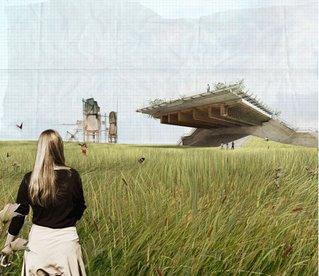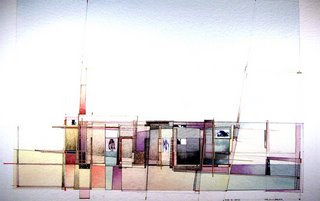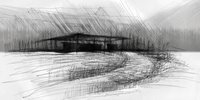 The 2006 Ken Roberts Memorial Delineation Competion been a great success. On November 8th, the winners of the competition were announced during a special ceremony at the Dallas Museum of Art. Architect Randy Brown, whose work has been published nationally and even internationally, was the main juror of the competition and explained to the public in attendance the merits of the winning entries. There were overall 4 winners, 4 juror's awards, and 25 or so finalists in which all the entries were presented at the reception on plasma screens as well as inside the auditorium. You can view the winning work at the Ken Roberts Competition website, krob06.com.
The 2006 Ken Roberts Memorial Delineation Competion been a great success. On November 8th, the winners of the competition were announced during a special ceremony at the Dallas Museum of Art. Architect Randy Brown, whose work has been published nationally and even internationally, was the main juror of the competition and explained to the public in attendance the merits of the winning entries. There were overall 4 winners, 4 juror's awards, and 25 or so finalists in which all the entries were presented at the reception on plasma screens as well as inside the auditorium. You can view the winning work at the Ken Roberts Competition website, krob06.com.There was a seven-fold increase in the number of entries submitted compared to the year before, and the quality of the work in general was on average much higher as well. More than just mere projections of a building's plans and elevations, the drawings crossed into the realm of art and in some incorporated techniques often found in graphic design. Compostion, color, and
 overall expression were more important the merit of the building's design. The KROB finalists demonstrate that architects are more than mere technical designers of structures; they are attentive to aesthetic expression, in pleasing the eye and making something that moves the soul, even in the form of a sketch. Maybe putting all this attention to detail on such artistic pursuits explains why architects are underpaid compared to other professions, but it's also why our profession attracts so many bright young people to it.
overall expression were more important the merit of the building's design. The KROB finalists demonstrate that architects are more than mere technical designers of structures; they are attentive to aesthetic expression, in pleasing the eye and making something that moves the soul, even in the form of a sketch. Maybe putting all this attention to detail on such artistic pursuits explains why architects are underpaid compared to other professions, but it's also why our profession attracts so many bright young people to it.Although a solidly consistent set of plans help assure the completion of a building as smoothly as possible, it is often architectural renderings that will give a project the financial go-ahead. They are crucial in marketing the proposed design, generating interest among potential tenants, and inspire owners to persist in seeing the job through. Floor plans invite a client to point to flaws in a building's functions, but renderings of a project are often immune to functional criticism. They instead set the tone of the project, the desired moods of a future place. When a rendering becomes more an "objet d'art" than just a pretty picture, it infuses an evocative quality to the building.
In my opinion, a large part of what architectural design comprises
 of is a a careful meditation of three dimensional forms in light. There's only so much importance that can be given to technology, as such matters don't contribute much to a building's meaningfulness within its cultural context. As a creative endeavor, architecture should strive to surpass fulfilling programmatic requirements and actually produce something beautiful, something that moves us. Le Corbusier encapsulates this ideal so clearly when he wrote:
of is a a careful meditation of three dimensional forms in light. There's only so much importance that can be given to technology, as such matters don't contribute much to a building's meaningfulness within its cultural context. As a creative endeavor, architecture should strive to surpass fulfilling programmatic requirements and actually produce something beautiful, something that moves us. Le Corbusier encapsulates this ideal so clearly when he wrote: "The Architect, by his arrangement of forms, realizes an order which is a pure creation of the spirit; by forms and shapes he affects our senses to an acute degree and provokes plastic emotions; by the relationships which he creates he wakes profound echoes in us; by the relationships which he creates he wakes profound echoes in us, he gives us the measure of an order which we feel in accordance with that of our world, he determines the various movements of our heart and of our understanding; it is then that we experience a sense of beauty."
"The Architect, by his arrangement of forms, realizes an order which is a pure creation of the spirit; by forms and shapes he affects our senses to an acute degree and provokes plastic emotions; by the relationships which he creates he wakes profound echoes in us; by the relationships which he creates he wakes profound echoes in us, he gives us the measure of an order which we feel in accordance with that of our world, he determines the various movements of our heart and of our understanding; it is then that we experience a sense of beauty."Take the time to visit the Ken Roberts website and keep in mind Le Corbusier's notions when viewing the winning entries.

No comments:
Post a Comment